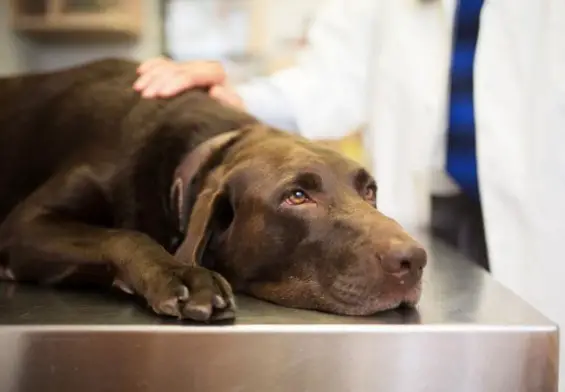Canine Lymphoma When to Euthanize?
If you have had an experience with dogs with Lymphoma, then this article’s information will not be new to you. But it will guide you on the best way to manage it. The same goes for people who have not had the experience before.
Your dog is precious to you. Most people share a strong emotional attachment with their dog; a man once willed his property to his dog. Dogs, too, are very loyal to their owner, hence the strong connection.
Because of this strong connection, it can be quite hard to put your dog down even when you have a reason to. It can be very upsetting. One of the reasons dog owners have to put their pet down is when they are diagnosed with an intense ailment.
Ailments like Lymphoma requires you to euthanize your dog. It is not as easy as it seems. You will not be sure of how much time your dog has to live. In situations like this, it is best to seek the vet’s advice on the right time to euthanize your dog.
It is usually in the best interest of your dog that you euthanize him. So if your dog is down with Lymphoma and is not responding to treatment, or it seems like your dog is going through severe pain, it is best to euthanize them.
Perhaps you are still confused, and you feel hopeless because your dog is down with Lymphoma, do not be discouraged. As you keep reading this article, you will find useful information to support you, and you can learn from the real-life experience mentioned.
What is Lymphoma and What are the Symptoms of Lymphoma?
You must know about Lymphoma; the knowledge will help manage it.
Lymphoma is an acute disease which can affect animals and people. When the disease affects a dog, it is referred to as canine Lymphoma.
The disease is a dangerous one; it attacks the lymphocytes in the body. Lymphocytes are white blood cells that typically synchronize with the body’s immune system and prevents pets and people from infections.
There are no less than thirty canine lymphomas. However, 4 of them occur more often than others. They include:
- Multicentric Lymphoma: this is the most common form of Lymphoma; it accounts for about 85 percent of lymphoma cases in dogs. This cancer affects the lymph nodes.
- Alimentary Lymphoma: it causes problems to the dog’s intestine.
- Mediastinal Lymphoma; this cancer causes the thymus and the mediastinal lymph nodes to swell up because of high-grade malignant T lymphocytes present. This cancer does not occur so often, like others.
- Extanodal Lymphoma: this type of cancer targets the dog’s skin, eye, kidneys, lungs, and central nervous system.
In some cases, Canine Lymphoma usually shows symptoms in dogs, while other dogs might be asymptomatic. Some other dogs may have trouble breathing. They may also show signs of vomiting, weight loss, diarrhea, lethargy, loss of appetite, excessive thirst, weakness, and other behavioral changes.
There might be other symptoms of Lymphoma depending on the type which your dog has been diagnosed with. For instance, you might find cuts with a scaly texture on your dog’s mouth or skin if they have cutaneous Lymphoma, which is a form of extranodal Lymphoma.
What Causes Lymphoma?
Unfortunately, there is no exact known cause of Lymphoma yet, just like other forms of cancer. If your dog is down with Lymphoma, it could be due to various factors, but it is unsure where it came from.
The Lymphoma could result from your dog’s exposure to herbicides, phenoxy acetic acid, or magnetic fields. It could also be a result of other environmental factors.
It is usually hard to pinpoint a particular cause of Lymphoma for now. Hopefully, there will be more information on it in the nearest future.
What Treatment Can You Give to Your Dog with Lymphoma?
Dog owners should focus more on the treatment of Lymphoma than the cause especially since the cause is currently unknown. Dog owners should be more concerned about how to treat their dogs.
The good news is that there are treatments available to help your dog through Lymphoma.
As we know that Lymphoma can breed in many areas in a dog’s body, that is why many veterinary doctors recommend chemotherapy above surgery.
CARES (Center for Animal Referral & Emergency Services) stated that most dogs that go through chemotherapy to treat Lymphoma would feel better up to ninety percent.
Although such remission may be partial or complete, it helps the dog relieve the symptoms if he has been having any before. However, even with chemotherapy, the Lymphoma could still come back as it is not totally gone.
You can consider your dog cured only when Lymphoma is totally gone. According to CARES, only fifteen percent of canines are usually totally cured of Lymphoma.
Although this does not imply that you and your dog will not enjoy having each other’s company even if they are not totally free from Lymphoma, that is, your dog can still enjoy its life even with cancer.
Perhaps you are nervous about how your dog will handle chemotherapy. No need to worry; there is hope. While people get sick and even lose their hair during chemotherapy, the case is different with dogs.
Dog breeds like Poodle, Old English sheepdog, and Bichon Frise do experience hair loss. It would be best if you speak to your vet before the chemo commences. This would help you to know what to expect and what may like happen to your dog.
Some chemotherapy treatments given to people can be administered on dogs with Lymphoma too. For example, multicentric Lymphoma can be treated using the UW-25 chemotherapy procedure. On the other hand, CCNU or Lomustine is used to treat cutaneous Lymphoma.
Naturally, your dogs may experience energy loss during their chemo, so they may not be so active. They could also have a loss of appetite coupled with vomiting and diarrhea.
When to Put down your dog with Lymphoma
Since your dog was diagnosed with Lymphoma, you have probably done all you can for them to feel better. You have worked with your vet to administer various treatments to your dog. You have even tried chemotherapy because you are convinced that t is the best option.
You might then wonder if there is still a need to put your dog down, or probably you do not know when and how to do it. Kindly read along.
If your dog enters remission after chemo, but the remission is partial, you can wait several months again and retry chemo. If your dog is still not totally cured, you might need to euthanize them because it does not seem they will ever be free from Lymphoma.
We mentioned earlier in the article that some dogs are asymptomatic and that your dog can still sometimes live fine even in remission; in such cases, there is no need for euthanasia. But you should always consult your vet often to be sure your dog leads a normal life.
On the contrary, it is right to euthanize your dog if you notice any uncomfortable symptoms like vomiting, lack of energy, diarrhea, or you see that the cancer is causing your dog so much pain.
You may also consider euthanasia if your dog’s quality of life has reduced and may not get better. Similarly, if your dog does not respond positively to lymphoma treatments or you are not happy with the chemotherapy results, you can euthanize the dog.
It is best to consult your vet when you want to put your dog down. The vet may recommend new treatments you are yet to try. The treatment may be the turning point and eliminate the need for euthanasia.
In other cases, your vet could also concur with you and guide you through the euthanasia and give you tips on the resources that will aid you. Some vets can even help you perform the task, although it is not easy for them too.
Coping with The Loss of Your Dog
It can be very saddening to have to euthanize your dog but remember that is it the best choice. After the process, you might be down with a heavy heart. It is normal. It is probably because of your affection for your dog.
Here’s how to overcome and deal with your pain:
- You can have a memorial for your dog where you and your family get to say goodbye.
- Allow yourself to grieve. It usually helps to let out one’s feelings rather than hiding them.
- Feel free to talk about your pet with your loved ones—reminiscence on the favorite moments with your dog.
- Get help from a counselor if need be. Or get a support system you can share your grief with.
- Know that it is normal to feel guilty about euthanizing your dog. But you know that what you did was best for your dog.
Conclusion
Lymphoma is a dangerous disease; the one that occurs in dogs is called canine Lymphoma. Different forms of Lymphoma may show up in different parts of the body and cause various symptoms.
The cause of Lymphoma in dogs is currently unknown, but chemotherapy treatment helps the situation in most cases. However, in cases where chemotherapy does not work for your dog, you may need to euthanize the dog to ease the pain.
It is usually hard and painful to put your dog down, but it is necessary because you do not want to see your dog suffer.





